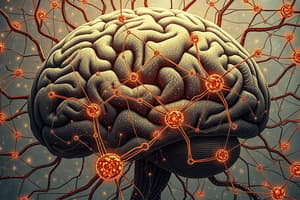Podcast
Questions and Answers
What is a key characteristic of a neural network when used for regression tasks?
What is a key characteristic of a neural network when used for regression tasks?
- It requires labeled data for output interpretation.
- It utilizes a sigmoid function on the output node.
- The output will always be categorical.
- The output is numerical without using activation functions. (correct)
Which of the following statements accurately reflects a limitation of ANN?
Which of the following statements accurately reflects a limitation of ANN?
- They often lack transparency in their operation. (correct)
- They require very little training data to function effectively.
- They are easy to interpret and understand.
- They can handle both linear and nonlinear relationships.
In the context of classification versus regression in ANN, how do their outputs differ?
In the context of classification versus regression in ANN, how do their outputs differ?
- Regression outputs can be categorical.
- Classification outputs tend to be numerical.
- Regression models do not require any labels for predictions.
- Classification outputs are often interpreted as class labels. (correct)
What type of learning does an ANN utilize when predicting property values?
What type of learning does an ANN utilize when predicting property values?
What is the primary function of the hidden layer in a neural network?
What is the primary function of the hidden layer in a neural network?
When applying ANN in data mining, which of the following learning types is suitable for finding patterns without predefined labels?
When applying ANN in data mining, which of the following learning types is suitable for finding patterns without predefined labels?
What is one way an ANN achieves improved prediction for complex outputs?
What is one way an ANN achieves improved prediction for complex outputs?
In the context of a loan appraiser model, what does it mean for an ANN to be considered a 'black box'?
In the context of a loan appraiser model, what does it mean for an ANN to be considered a 'black box'?
What is a unique feature of Artificial Neural Networks (ANN)?
What is a unique feature of Artificial Neural Networks (ANN)?
In the context of predicting survival based on features, what represents the output of the ANN?
In the context of predicting survival based on features, what represents the output of the ANN?
Which statement best describes the application of multi-layer networks in ANN?
Which statement best describes the application of multi-layer networks in ANN?
What is generally considered a primary advantage of using ANN for classification tasks?
What is generally considered a primary advantage of using ANN for classification tasks?
What is one of the weaknesses of artificial neural networks?
What is one of the weaknesses of artificial neural networks?
Which of the following is a difference between regression and classification in the context of ANN?
Which of the following is a difference between regression and classification in the context of ANN?
How do backpropagation algorithms improve ANN training?
How do backpropagation algorithms improve ANN training?
What role do hidden layers play in an ANN?
What role do hidden layers play in an ANN?
What is the iterative process involved in training a neural network primarily focused on?
What is the iterative process involved in training a neural network primarily focused on?
What characterizes the function of an artificial neural network with multiple hidden layers?
What characterizes the function of an artificial neural network with multiple hidden layers?
What is a common application of Artificial Neural Networks?
What is a common application of Artificial Neural Networks?
Which of the following best identifies a characteristic of generative AI in relation to ANN?
Which of the following best identifies a characteristic of generative AI in relation to ANN?
In the context of the back propagation algorithm, what triggers the adjustment of coefficients?
In the context of the back propagation algorithm, what triggers the adjustment of coefficients?
What distinguishes regression tasks from classification tasks in artificial neural networks?
What distinguishes regression tasks from classification tasks in artificial neural networks?
Which of the following is a strength of artificial neural networks?
Which of the following is a strength of artificial neural networks?
What is a documented drawback of artificial neural networks?
What is a documented drawback of artificial neural networks?
In applications like speech recognition and handwriting recognition, what role do artificial neural networks play?
In applications like speech recognition and handwriting recognition, what role do artificial neural networks play?
What is the purpose of using a threshold in a single output node for classification tasks?
What is the purpose of using a threshold in a single output node for classification tasks?
What does the term 'overfitting' refer to in the context of training neural networks?
What does the term 'overfitting' refer to in the context of training neural networks?
Which application is an example of using artificial neural networks for financial analysis?
Which application is an example of using artificial neural networks for financial analysis?
Flashcards are hidden until you start studying
Study Notes
Neural Network Architecture
- Weights in a neural network determine the function it computes
- A neural network with 2 hidden layers can approximate any nonlinear function
- Weights are learned and updated during training, reflecting the function mapping inputs to outputs
Training Process
- Training is iterative
- The network starts with random initial weights
- For each training example:
- The network calculates the output
- The error between the predicted output and the target output is calculated
- Weights are adjusted based on the error
- The process repeats until the error is sufficiently small or the weights converge
- One round of training on all samples is called an epoch
Back Propagation Algorithm
- The algorithm used for training neural networks
- Randomly chooses initial weights
- Iterates through training records until the total squared error is small enough
- For each training record:
- The input data is applied to the ANN
- The output for each neuron is calculated, from the input layer through the hidden layers to the output layer
- The error at the outputs is calculated
- Error signals are computed for previous layers based on the output error
- Coefficients are adjusted based on the error signals
- The process reiterates for each record
Applications of Neural Networks
- Can be trained for regression or classification
- Regression: Predicts continuous variables
- Classification: Predicts one or more classes
- Two classes: single output node with threshold
- Multiple classes: multiple outputs, one per class
- The predicted class is the output node with the highest value
- Often called a "Universal Approximator" as the combination of simple units provides flexibility
Strengths and Weaknesses
- Strengths:
- Can learn very complex functions accurately with sufficient training data
- Built-in nonlinearity
- Can be trained for classification and regression
- Handles noisy data well
- Drawbacks:
- Considerable training time
- Black box: explaining how the ANN learns is difficult
Successful Applications
- Text to speech: NetTalk
- Speech recognition
- Handwriting recognition
- Machine translation
- Driverless vehicles
- Fraud detection
- Financial applications: FICO credit score
- Credit approval/disapproval models
- Chemical plant control: Pavillion Technologies
- Game playing: Neurogammon
The Number of Hidden Layers
- It depends on the complexity of the problem
Multi-Layer Networks
- Inputs are fed into the network
- Each input is multiplied by a weight and summed to determine the value for each hidden neuron
- Each hidden neuron applies an activation function to its weighted sum
- The hidden neurons are fed to the output layer, where the same process occurs
- The output layer produces the final prediction
Supervised and Unsupervised Learning
- Supervised learning: Labels are used to train the model
- Unsupervised learning: No labels are available and the model learns based on patterns in the data
- Regression predicts continuous variables, while classification predicts discrete categories
- Common supervised learning algorithms:
- Linear Regression
- Nonlinear Regression
- Decision Trees, C&RT
- Logistic Regression
- ANN
- Common unsupervised learning algorithms:
- Association rules
- Clustering
Deep Learning
- A subset of machine learning
- Often uses neural networks with multiple hidden layers
- Many successful ML models, including deep learning and generative AI, are based on ANNs
ANN Uniqueness
- Can learn complex, nonlinear separation boundaries
- Two or more hidden layers can approximate any nonlinear function
- Example: Predicting 5-year survival based on age, gender, and stage of cancer
Trained One Hidden Layer ANN
- Inputs: Age, Gender, Stage
- Output: Probability of being alive
- Hidden layer: Weighted sum of inputs, passed through an activation function
- Prediction: The probability of the output node
Predicting Survival Example
- Different weight values result in different probability predictions
- Shows how the network learns to approximate complex relationships between inputs and outputs
AI, ML and Deep Learning
- AI (Artificial Intelligence) is a broad field
- ML (Machine Learning) is a subfield of AI that focuses on getting computers to learn from data
- DL (Deep Learning) is a subfield of ML that uses artificial neural networks with multiple hidden layers
Multi-Layer Networks: A Black Box
- Illustrates the complexity of a neural network in predicting a property value
- It is difficult to explain exactly how the network arrives at its prediction
Real Estate Appraiser
- Neural networks can be applied to predict housing prices using features like location, size, and amenities
Loan Prospector - Loan Approval
- An example of a black box neural network
- Predicts the probability of a loan being approved
- Many factors impact the prediction, but the specific calculations aren't easily interpretable
Single Hidden Layer ANN for Classification
- An illustration of a single hidden layer ANN for classifying data points into different classes
- The network learns to separate data points based on different features
ANN Examples in WEKA
- Demonstrates the use of ANN for regression in WEKA
- The example uses the Cpu.arff dataset, which includes 6 attributes and a numerical output
- ANN does not use the sigmoid function on the output node for regression problems, but rather a linear activation function.
Studying That Suits You
Use AI to generate personalized quizzes and flashcards to suit your learning preferences.




